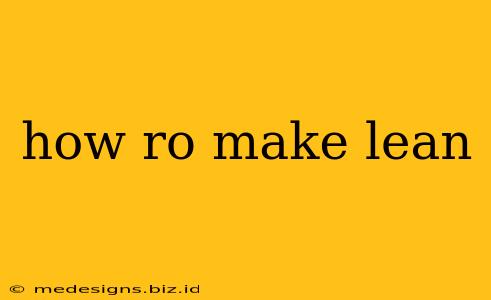Lean manufacturing, often shortened to just "lean," is a powerful methodology focused on eliminating waste and maximizing value for the customer. It's not just for factories; lean principles can be applied to any process, from software development to healthcare. This guide will break down how to implement lean in your organization.
Understanding Lean Principles
Before diving into implementation, let's clarify the core tenets of lean:
- Value: Define value from the customer's perspective. What are they willing to pay for?
- Value Stream: Map out all the steps involved in delivering that value, identifying both value-added and non-value-added activities.
- Flow: Optimize the value stream to ensure a smooth, continuous flow of work.
- Pull: Produce only what is needed, when it's needed, based on customer demand.
- Perfection: Continuously strive to eliminate waste and improve processes.
Identifying Waste (Muda)
A crucial step in implementing lean is identifying and eliminating waste. The seven common types of waste (Muda) are:
- Transportation: Unnecessary movement of materials or information.
- Inventory: Excess stock tying up capital and space.
- Motion: Unnecessary movements by people or equipment.
- Waiting: Delays in the process.
- Overproduction: Producing more than is needed.
- Over-processing: Doing more work than is necessary.
- Defects: Errors requiring rework or scrap.
Identifying these wastes requires a thorough analysis of your processes. Tools like value stream mapping can be invaluable here.
Implementing Lean Principles: A Step-by-Step Approach
Implementing lean is an ongoing journey, not a destination. Here’s a structured approach:
1. Define Value:
Start by clearly defining what constitutes value from the customer's point of view. This forms the basis for all subsequent decisions.
2. Map the Value Stream:
Use value stream mapping to visually represent all steps involved in delivering value. This will highlight areas of waste and bottlenecks.
3. Improve Flow:
Focus on eliminating waste and streamlining processes. This might involve reducing inventory, improving workflow, or automating tasks.
4. Implement Pull Systems:
Introduce Kanban or other pull systems to ensure production is driven by customer demand rather than forecasts.
5. Strive for Perfection (Kaizen):
Embrace continuous improvement through regular Kaizen events – short, focused improvement projects involving the entire team.
Tools and Techniques for Lean Implementation
Several tools and techniques can help you implement lean effectively:
- Value Stream Mapping: A visual representation of the process, identifying value-added and non-value-added steps.
- 5S Methodology: A system for workplace organization: Sort, Set in Order, Shine, Standardize, Sustain.
- Kanban: A visual system for managing workflow and limiting work in progress.
- Poka-Yoke: Error-proofing processes to prevent defects.
- Kaizen Events: Short, focused improvement projects.
Measuring Success in Lean Implementation
You need to track key metrics to gauge your progress. These might include:
- Lead time: The time it takes to complete a process.
- Inventory levels: The amount of stock held.
- Defect rates: The number of errors or defects.
- Throughput: The rate at which value is delivered.
- Customer satisfaction: How satisfied are your customers with your product or service?
Consistent monitoring and adjustments are essential for successful lean implementation.
Conclusion: Embracing the Lean Journey
Implementing lean manufacturing requires commitment, dedication, and a willingness to continuously improve. By focusing on eliminating waste and maximizing value, you can significantly improve efficiency, reduce costs, and enhance customer satisfaction. Remember, it’s a journey, not a destination—constant improvement is the key to success.
